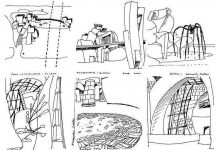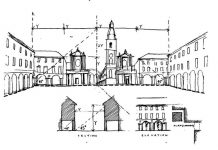There is an undisguised air of evangelism running through this book, for it seeks to encourage students of architecture, craft and design to forsake their cameras and learn the art of freehand sketching. Drawing is not only more enjoyable and far more educational, but the end product is more likely to remain a cherished object than would an anonymous slide or photographic print. Drawing an object, building or townscape forces you to engage more directly in the subject than as a mere photographer; the search to record shape, proportion, detail and colour requires greater effort and more skilled observation than that needed to press the shutter of a camera. The discriminatory eye encouraged through sketching has value to the potential designer and tourist alike for it engages the observer in an important dialogue with his or her subject.
Until fairly recently the sketchbook was the accepted accompaniment of all students of architecture or landscape, and of many interested tourists. In many ways Prince Charles maintains this honourable tradition. Before photography became more affordable and part of our visual culture, the sketch remained the means to record and analyse an interesting town, building or piece of furniture. You have only to look at the sketchbooks of famous architects – from Robert Adam to Charles Rennie Mackintosh – to see how valued was the freehand sketch. Its use was often beyond that of mere record or pretty picture: invariably the sketch was the means of noting down a particular detail or type of composition that could be used when the right design commission came along. For instance, Adam’s sketches of the fortifications of the Dalmation coast were transformed in less than a decade into the eighteenth-century Scottish castles occupying a more northern coastline.
Many students of architecture and design today spend a great deal of time making photographs rather than sketches. They could, of course, buy postcards or tourist guides, which often contain better and more accurate pictures at only a fraction of the cost, thereby concentrating their efforts instead on the harder but more valuable process of drawing. What the sketchbook provides is a means of delving deeper into the subject than merely recording it, in order to begin to understand why and how the scene was shaped. The main barrier to using the sketchbook in this way appears to be the lack of basic graphic skills, together with the hectic pace of modern life. As with all endeavours of value, you have to practise a great deal to cultivate the craft of freehand drawing, in order to fulfil the potential offered by the sketchbook.
The drawing skills are outlined in this book under simple headings such as shade, line weight, composition and rules of perspective. As with learning to play a musical instrument, you have to spend time practising and training eye-to-hand coordination The rules of drawing are, like the rules of grammar or numeracy, based upon a language we all share and understand. By combining elements of the ‘craft of drawing’ with ‘graphic rules’, you will quickly develop a technique suitable to your particular needs – whether as a student of architecture, design or landscape, or simply as an inquisitive tourist on holiday abroad.
The process of sketching is not presented in these pages as an end in itself, but as a means of raising the student’s awareness of design by cultivating careful, well- directed skills of observation. The sketch is both a record and a statement of visual inquiry. The act of drawing from life, be it of a town or a building, is to engage the artist in the subject in a unique and rewarding fashion. If the sketch is undertaken in the spirit of formal investigation then the results can be considerable in terms of the development of personal design skills. The linear progression from sketchbook analysis to design proposal is one that many architects have experienced. The detailed study of a subject through the freehand drawing leads naturally to creative design by opening up different possibilities. Analysing existing buildings through the pages of the sketchbook provides a useful springboard for progressing into design. The precedents explored are of value in themselves, but, more importantly, the formal, spatial and decorative language employed in examples that have been sketched may prove applicable to the design of new buildings.
To take advantage of the progression from freehand drawing to creative design, the artist must approach the subject in a considered fashion. The outline is important and so are the proportions, and often a relationship exists between the building in plan and how it works in section and elevation. As we tend to draw the outsides of build- ings, the potential designer should not focus upon the façades at the expense of the often critical relationship between elevation and plan. These ‘invisible’ relationships may be the most instructive when drawing certain buildings, and provide a source of ideas for the designer.
A good sketch is not necessarily a faithful likeness; it may in a pedagogic sense be better to analyse and decipher the subject. Sketches that consist of probings around specific themes may prove particularly useful to designers since they provide fruitful avenues for further exploration. Charles Rennie Mackintosh was a particular master of this type of sketch, and drawings from his Italian Tour of 1891 demonstrate a concern for form and decoration that are obvious precursors of his later designs. In his sketchbook drawings Mackintosh explores the volumetric nature of Italian churches, the simple, almost abstract forms of farmhouses, and the black and white decoration of Romanesque chapels. These images, and the facility Mackintosh developed for representing them, find expression, either directly or indirectly, in his later designs for schools and houses. Similar sketchbook studies of Celtic art and architecture, and of wild flowers sketched whilst living in Suffolk, proved a parallel path into creative design for Mackintosh.



















